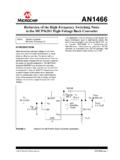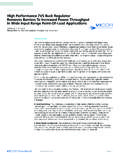Transcription of NexFETTM High Performance MOSFETs - Texas Instruments
1 Application Report SLPA010 November 2011 1 Ringing Reduction Techniques for NexFETTM high Performance MOSFETs ABSTRACT The design of switching converters with high Performance MOSFET s such as those found in the NexFETTM product line require special attention to detail to maximize the effectiveness of the devices and optimize the overall Performance of the switching function. Consideration of the challenges of working with ultra-fast power devices early in the design process will ensure the highest performing, most reliable final product. In this Application Note, the Power Stage of the typical Non-Isolated Synchronous Buck Converter (see Figure 1) will be used as a reference for discussing practical design considerations for maximizing the Performance and lifetime of NexFET products.
2 The most common problem encountered in this scenario is parasitic Voltage Ringing superimposed on the rising edge of the Switch Node. This Application Note will discuss the source of the switch node ringing, measurement techniques to accurately characterize this ringing, and methods for minimizing the effect while maintaining excellent system Performance . Backgound Figure 1 shows the schematic of a typical synchronous buck converter. As the Performance of power devices is improved, the control FET has the ability to switch voltages at rates greater than 10kV/ s. However, the fast switching faces a common challenge of dealing with switching noise. In particular when the Control FET turns on and the Sync FET is off, the loop inductor, the loop resistor and the output capacitor of the sync FET form a series RLC loop and will resonate at a resonant frequency.
3 This resonance will result in voltage overshoot and ringing at the switch node. PWMC ontrolFETSyncFETI nput SupplyLOILCOLoadDriverDriverCISwitch Node Figure 1. Definition of Power Stage Components To understand the source of this ringing, it is useful to make a detailed examination of the switching transient. Assume the Control FET is off, the Sync FET is on, all voltage transients have settled, but IL continues to flow (slewing at a constant rate) (see Stage 1 in Figure2). During Stage 2, the Sync FET is turned off and a short deadtime is imposed to prevent shoot-through before the Control FET is turned on. During the deadtime the inductor current forces the body diode of the Sync FET to turn on, resulting in a slight drop in voltage at the Switch Node.
4 Stage 3 is initiated by the turn on of the Control FET. As current builds in the Control FET (limited by parasitic inductance and the on resistance of the FET), the body diode of the Sync FET is forced off. The reverse recovery effect of the diode and the slewing of the FET capacitor voltages result in overshoot of the Control FET current. NexFET is a Trademark of Texas Instruments SLPA010 2 This current overshoot is absorbed by the output capacitance of the FETs, resulting in overshoot of the Switch Node voltage. The FET capacitances and the parasitic inductance (package inductance, poor layout , etc.) create the resonant network which results in Switch Node Ringing (seen in Stage 3). Control FET VGSSync FET VGSS witch NodeVINVPKS tage 1 Stage 2 Stage 3 Stage 4 Stage 5 Stage 1 Inductor Current Figure 2.
5 Switching Waveforms with Exaggerated Switch Node Detail There are two major industry concerns regarding this ringing commonly found to be superimposed on the Switch Node waveform: 1. Voltage Margin a. This is a percentage ratio which takes the magnitude of the first peak within the ringing waveform and compares it to the Breakdown Voltage of the Power MOSFET (BVDSS). 2. EMI/EMC a. This the amount of conducted or radiated noise produced by the ringing waveform. This Application Note will only address the topic of Voltage Margin and will not focus on the topic of EMI/EMC. The topic of EMI/EMC can be somewhat subjective and highly dependent on the overall system/chassis design. However, the enhancements outlined in this paper should somewhat improve the overall EMI/EMC Performance of the system in relative terms.
6 In addition, there are published (1) (2) papers that have focused on addressing the EMI/EMC effects in these applications. In terms of Voltage Margin, customers tend to impose an 80% margin rule. This means the maximum voltage measure across the Drain to Source of any MOSFET should not exceed 80% of the MOSFET s BVDSS. For example, a MOSFET with a BVDSS = 25V would be required to only sustain 20V applied across the device at any given time. As such, power supply designers need to have a solution to address a situation that yields ringing that may exceed their Voltage Margin requirements. SLPA010 3 Proper Switch Node Measurement Techniques Before voltage margin improvement techniques are discussed, it is valuable to discuss how to properly measure the switch node waveform to accurately capture the ringing transient.
7 It is important, when taking this measurement, to probe as close as possible to the device in question. This ensures that the actual stress on the device is measured accurately. Figure 3 shows a sample layout of the power stage components using discrete FETs with some possible probe points marked. Figure 3. Sample Power Stage layout (Inductor and Driver Not Shown) with Potential Probe Points Marked Figure 4 shows the effect of improper sensing. On the left, a single-ended measurement (shown in Magenta) is taken at point B and compared to the proper differential measurement (shown in blue) taken from point B to point A. The single-ended measurement reports a peak voltage lower than the actual stress on the device.
8 On the right side of Figure 5 the proper differential measurement (shown in yellow) is compared to a differential measurement taken a short distance away from the low-side device (point D to point C). In this case, the difference is only In both cases, the problem is stray inductance between the measurement and the device. Even with a differential measurement taken on the primary pours but not directly on the device pads, a significant drop in the peak voltage is detected. Improper measurement techniques can lead to unnecessarily high margin requirements resulting in less efficient designs. SLPA010 4 Figure 4. LEFT: Single-Ended (Magenta) Versus Differential (Blue) Measurement RIGHT: Differential Sensing near device (Yellow) and far from device (Blue) If it is not feasible to perform differential sensing, suitable sensing can still be performed with a single-ended oscilloscope probe, however, the following tips will help to minimize the overall error.
9 1. The ground lead length of an oscilloscope probe is the most important item in properly capturing the peak values of the switch node voltage ringing. Do not use the standard 3-inch long ground wire supplied with the oscilloscope probe. The long wire loop will act as an antenna by picking up any radiated noise emmitted by the system board and will yield a higher value of switch node voltage ringing than what is actually seen by the device (see Figure 5 and Figure 6). Instead use a small-length ground wire that attaches to the oscilloscope probe tip end (see Figure 7). 2. Placement of the oscilloscope tip and ground must be right on the MOSFET leads (same as in the differentially sensed case). Placement anywhere else introduces higher voltage ringing induced by the PCB parasitic inductance.
10 3. Figure 5. Ringing Voltage Pick-up by 3-Inch Ground Wire SLPA010 5 Figure 6. Switch Node Voltage Ringing Measurements: Typical 3-Inch Wire (Left) Versus Small Length Wire (Right) Figure 7. Oscilloscope Probe Comparison: Typical 4-Inch Wire (Left) Versus Small Length Wire (Right) Methods for Reducing Switch Node Ringing A number of methods have been widely used to minimize the switch node ringing. These methods are listed as follows: 1. Careful PCB layout to minimize the parasitic loop inductance in circuit [1].











